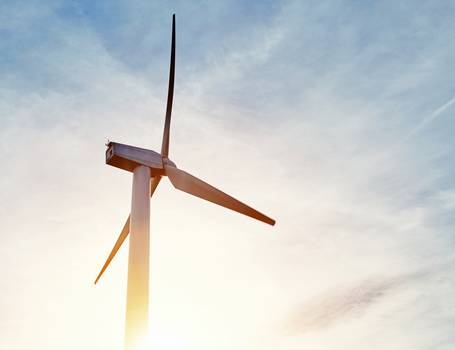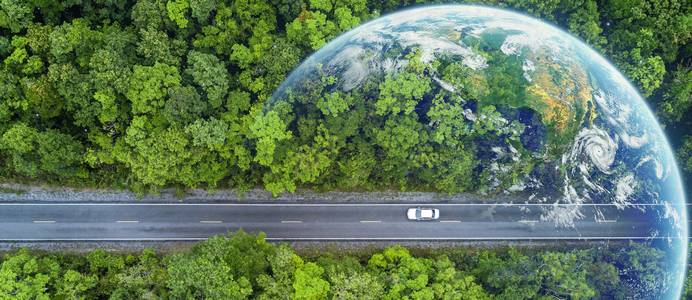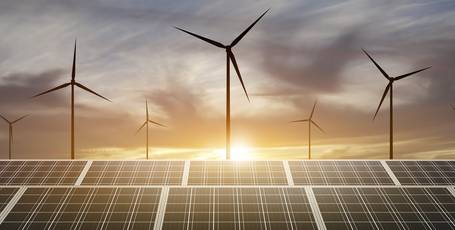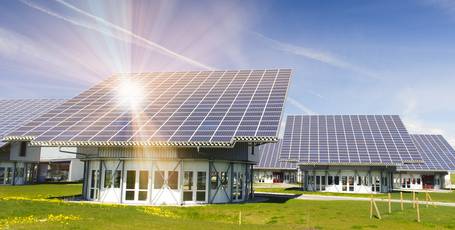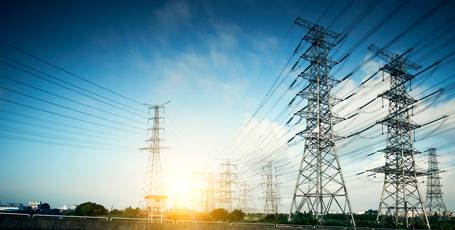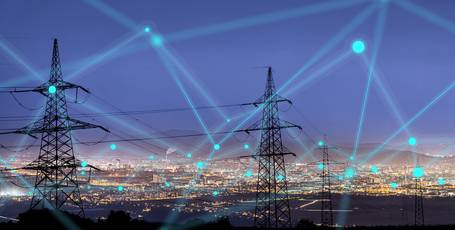Energy transition » Alternative energy through renewable energies
In view of the growing global challenges, renewable energies are becoming increasingly important as an alternative to limited fossil fuels. The following topics therefore play an important role in the transformation towards a sustainable future, as they are closely linked to the energy transition:
Germany wants to fundamentally change its energy supply. The energy transition is a long-term goal of the German government, at the end of which the supply should be predominantly secured by renewable energies in order to reduce greenhouse gas emissions and reduce dependence on fossil fuels. For a long time, electricity and heat were mainly produced using fossil fuels such as coal, natural gas or oil. However, this is set to come to an end in the foreseeable future.
Currently, for example, the proportion of gross electricity consumption generated from renewable energy sources such as wind power or photovoltaics is just over 50 percent. The pace of expansion is increasing: from around 41% (2021) to 46.2% (2022) to date, the proportion of green electricity is continuing to rise. The goal: by 2030, it should be twice as much, at least 80%. To achieve this, the rate of expansion would have to almost triple compared to the current situation.
Gross electricity consumption includes all electricity generated from wind, solar, coal, oil, natural gas and other energy sources as well as the associated losses during conversion and transmission. In accordance with EU law, gross electricity consumption serves as a reference value for the share of renewable energies in the electricity mix.
Green energy sources: biomass and wind power
Looking at the distribution of renewable energy sources across all sectors - electricity, transport, heating - biomass (52%) and wind power (26%) account for the largest share of renewable energy sources by far, according to the Federal Environment Agency (AGEE-Stat, as at 02/2023). Followed by solar energy (14 %), hydropower (4 %) and geothermal energy (4 %).
The reason why biomass is the most important renewable energy source - and not wind or solar energy - is partly due to the wide range of possible applications in all sectors. Be it solid fuels for heating purposes, biofuels in transportation or biogas for electricity generation. Secondly, solid fuels made from organic materials such as plants, wood waste or agricultural residues are often abundant and can also be stored relatively easily. Biomass is therefore a flexible energy source that can be used to compensate for possible fluctuations in other renewable sources.
Wind power, on the other hand, makes the largest percentage contribution to electricity generation. It is an inexhaustible source of energy that is available all over the world and - as it produces no CO2 emissions during operation - is also climate-friendly. However, in order to guarantee a constant supply, a much greater expansion of wind power plants on land and at sea is necessary.
Hydrogen - the energy source of the future
When it comes to the energy source of the future, hydrogen is currently at the forefront. It can be used flexibly, is easy to transport, can be stored effectively and is also climate-friendly - provided it is produced using renewable energies.
As it can play an essential role in the fight against climate change, while at the same time ensuring a reliable energy supply, the German government has also updated and expanded its National Hydrogen Strategy:
- The plan: to make Germany climate-neutral by 2045.
- By 2030: Expand hydrogen capacity to 10 gigawatts.
- By 2027/2028: Build a power grid with 1,800 kilometers.
This strategy outlines how Germany intends to use hydrogen in the future, bundles the measures of the Federal Government and sets state guidelines for the production, transportation and use of hydrogen in all areas.
The CO2 footprint varies depending on the type of production
An important goal: by 2030, hydrogen is to be increasingly used in industry, heavy commercial vehicles and in air and sea transport, transforming these sectors in a climate-friendly way. At the same time, hydrogen-capable gas power plants should stabilize the power grid and guarantee a secure power supply. As the production of hydrogen can be easily controlled, it represents an important counterbalance to other renewable energies, which are predominantly dependent on wind and sun and can therefore show strong fluctuations.
However, not all hydrogen is the same. The carbon footprint varies depending on the source material and production method, meaning that the potentially green energy carrier can do more harm to the climate than good. This is why the different types are color-coded:
| Color coding | Description | Climate-friendly? |
|---|---|---|
| Green hydrogen | Produced by electrolysis of water. Electricity from renewable energies is used for production. As no CO2 emissions or other greenhouse gases are produced, it is considered a climate-friendly energy source. |
✓ |
| Grey hydrogen | The most common type of hydrogen. Produced by steam reforming of natural gas. This also produces CO2, which is released into the atmosphere and thus increases the greenhouse effect. |
X |
| Blue hydrogen | Also obtained from natural gas. Carbon dioxide emissions are captured and stored. (Storage technology CCS: Carbon Capture and Storage) Low-carbon but not carbon-neutral. |
✓ |
| Turquoise hydrogen | Produced by the thermal decomposition of methane. The by-product is a solid carbon (C), which is why no CO2 is released. To ensure that production remains CO2-neutral, renewable energies must be used and the carbon must be permanently captured. However, methane pyrolysis technology is still under development and is not as widely used as other hydrogen production methods. |
✓ |
| Orange hydrogen | Produced from bioenergy (biomass, biofuel, biogas or biomethane). During production (combustion), the greenhouse gases it contains are released. How much depends, among other things, on the type of energy source used and the efficiency of the production process. Although the carbon footprint is lower than for hydrogen from fossil fuels, it is still higher than for green hydrogen, which is produced using renewable energy sources. |
X |
| Red/pink hydrogen | Is produced using nuclear energy. Although production is CO2-free, uranium as an energy source brings its own environmentally damaging problems. For example, radioactive waste that has to be stored. |
– |
| White hydrogen | Naturally occurring hydrogen. Very rare. Like coal or oil, it can be extracted by drilling. However, some sources can also be tapped directly. Natural hydrogen production could theoretically be stimulated by pumping water into iron-rich rock. |
✓ |
* Until sufficient green hydrogen is available, this rather climate-friendly color hydrogen will also be promoted. Prerequisite: it must be low-carbon and produce comparatively few greenhouse gas emissions.
Artificial intelligence as a driver of transformation
Now that energy can be generated from renewable, environmentally friendly sources, another important issue is distribution. As energy from wind or sun can naturally be subject to fluctuations, intelligent, innovative solutions are needed to balance these out flexibly and as quickly as possible. This is because digitalization and new electricity consumers such as electric cars are causing demand to continue to rise. At the same time, the ongoing expansion of “green” systems is also contributing to the increasing complexity of the energy system to be managed. Where previously there were centrally controlled energy producers such as large power plants connected to high and extra-high voltage grids, the expansion of renewable energy sources requires increasingly decentralized control and much greater flexibility.
Artificial intelligence (AI) can be part of this solution and help to make the grid more efficient by improving the sustainability and reliability of energy production, distribution and use.
Forecast of weather-related fluctuations
AI can be used to optimize power generation from renewable energy sources such as wind and solar energy. Using so-called meta-forecasts and real-time analysis of weather data, AI can calculate, for example, how much wind there will be in a wind farm the next day or even in the next few hours, or how much solar energy will be available. This allows those responsible to prepare in advance for a shortage of wind energy or an expected surplus and act accordingly.
Power generation
AI can help to maximize energy production by using complex weather forecasting models and, based on these forecasts, controlling energy generation plants more efficiently in advance to achieve the maximum yield.
For example, AI can synchronize the turbines in wind farms and align them optimally with the wind or control solar modules so that they can make the most of the available light.
Power grid monitoring
Whereas energy used to be distributed only “from top to bottom”, energy is now also being fed into the grid “from below”. At the same time, more and more electric cars can lead to unexpectedly high consumption. The distribution grids are being used in a way for which they were not designed. There is little measurement technology or sensor technology at the lower levels to monitor operating states. AI can help by predicting grid conditions and peaks in energy generation and consumption more accurately and reliably than was previously possible, even with a comparatively small amount of data.
Energy management
If an imminent overload is detected thanks to AI-generated forecasts, countermeasures must be taken. One way to prevent bottlenecks in the grid is to intelligently coordinate the numerous flexible small and micro systems at distribution level. For example, self-organized systems in which every relevant unit in the electricity grid is equipped with AI software could interact and coordinate with other intelligent devices at a local level.
For example, not all electric vehicles in a street need to be charged at maximum power at the same time immediately after work. In most cases, it is sufficient for the vehicles to be ready to drive again by the morning.
Security of supply
By analyzing real-time data, AI can monitor the performance and behavior of energy infrastructure systems to detect anomalies early and trigger alarms when deviations from the norm occur. This allows potential problems to be identified and rectified at an early stage before they lead to serious disruptions.
It can also develop advanced models to predict energy demand in order to better plan power generation and distribution in general and, if necessary, take measures to increase performance and compensate for fluctuations. This enables a more efficient use of resources and can reduce the need for fossil fuels.
Maintenance
AI can optimize the maintenance of energy infrastructure such as power lines and turbines by enabling predictive analytics and predictive maintenance.
It is able to make precise predictions about the condition of energy infrastructure elements such as power lines, transformers and turbines based on real-time data and historical information. Maintenance work can thus be carried out exactly when it is needed instead of according to a fixed schedule. This means, for example, that a cable is replaced before the critical point is reached and it is actually damaged. This minimizes disruptions and significantly reduces interruptions to the supply.
